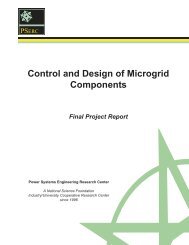Development and Evaluation of System Restoration Strategies from ...
Development and Evaluation of System Restoration Strategies from ...
Development and Evaluation of System Restoration Strategies from ...
You also want an ePaper? Increase the reach of your titles
YUMPU automatically turns print PDFs into web optimized ePapers that Google loves.
Executive Summary<br />
<strong>System</strong> restoration following a blackout is one <strong>of</strong> the most important tasks for power<br />
system operators. However, few on-line computer tools are available to help operators<br />
complete that task in real-time. Indeed, most power system operators rely on <strong>of</strong>f-line<br />
restoration plans developed for selected scenarios <strong>of</strong> contingencies, equipment outages,<br />
<strong>and</strong> available resources. Since the details <strong>of</strong> an actual blackout are hard to predict in the<br />
planning stage, a restoration plan can only serve as a guide in an actual system restoration<br />
situation.<br />
In this research, we used novel approaches to transmission <strong>and</strong> distribution system<br />
restoration to design modules that can be used in an on-line decision support tool. Using<br />
such a tool, once fully developed <strong>and</strong> tested, operators will be better able to adapt to<br />
changing system conditions that occur during an actual restoration. The research-grade<br />
modules include:<br />
• Generation Capability Optimization Module<br />
• Transmission Path Search Module<br />
• Constraint Checking Module<br />
• Distribution <strong>System</strong> <strong>Restoration</strong> Module.<br />
With additional development work, these modules could be linked <strong>and</strong> coordinated by a<br />
Strategy Module. Testing demonstrated the viability <strong>of</strong> these modules in identifying<br />
restoration decisions that we believe will reduce restoration time while maintaining<br />
system integrity. Ultimately, this will lead to lower outage costs for blackout events.<br />
The four developed modules provide an automated <strong>and</strong> “best adaptive strategy”<br />
procedure for power system restoration. Future work will be needed for extensive testing,<br />
implementation planning, <strong>and</strong> actual implementation in a real-time operational<br />
environment.<br />
Part I. Optimal Generator Start-up <strong>Strategies</strong> for Power <strong>System</strong> <strong>Restoration</strong><br />
(work done at Iowa State University)<br />
During system restoration, generation availability is fundamental for all stages <strong>of</strong> system<br />
restoration: stabilizing the system, establishing the transmission path, <strong>and</strong> picking up<br />
load. The generator start-up strategy is intended to provide an initial starting sequence <strong>of</strong><br />
all black start or non-black start units. Available black start units must provide cranking<br />
power to non-black start units in such a way that the overall available generation<br />
capability is maximized. The corresponding generation optimization problem is<br />
combinatorial with complex practical constraints that vary with time. Two methods were<br />
developed <strong>and</strong> demonstrated for a Generation Capability Optimization Module.<br />
First, by taking advantage <strong>of</strong> the quasiconcave property <strong>of</strong> generation ramping curves, a<br />
two-step algorithm was used for the generator start-up sequencing problem. The<br />
optimization problem was formulated as a Mixed Integer Quadratically Constrained<br />
Program (MIQCP). The solution method breaks the restoration horizon into intervals <strong>and</strong><br />
develops the restoration plan by finding the status <strong>of</strong> each generator during each time<br />
ii
















